Last Updated on September 20, 2020 by The Tutor
How to Layout Recessed Lighting in 5 Simple Steps

In preparation for your recessed lighting project, you will need to determine how to layout your recessed lighting before you begin. Understanding the layout will also help you to shop for recessed lighting fixtures and develop an installation game plan.
When determining how to layout recessed lighting, a good guideline is to place a minimum of one light for every 25 square feet of living space. This is just a basic guideline and every application may differ slightly based upon what you are trying to accomplish in the space and whether the room is irregular in shape.
When you are finished reading about how to layout recessed lighting, take a look at our recommended recessed lighting fixtures before you make your purchase. You will be surprised at how inexpensive they are.
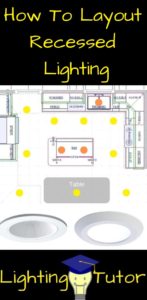
How to Layout Recessed Lighting in 5 Simple Steps
- Determine the purpose for your recessed lighting
- Identify the area that you need to light
- Decide on which recessed lights you will use
- Calculate the number of recessed lights needed
- Determine the layout of your Recessed lighting
Purpose for Recessed Lighting
- Recessed Accent lighting
- Recessed Task lighting
- Recessed Ambient or General Lighting
Recessed Accent Lighting – You will use recessed accent lighting when you are trying to highlight something in particular. For example, you may have a unique painting on the wall which you would like to feature. I also see fireplaces with recessed lighting pointed at the mantle. These are just a couple of examples of when you would use recessed lighting to add accent. In the photo below, you can see that the two recessed lighting fixtures have just one purpose and that is to accent the fireplace. This is why the recessed lighting layout for this room is different.
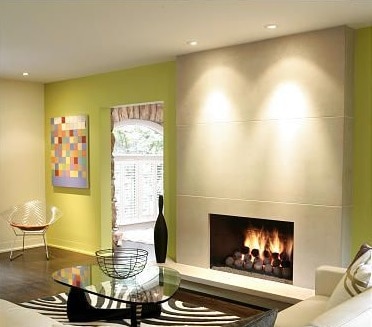
Recessed Task Lighting – You will use recessed task lighting when you are trying to provide light over a work area. For example, your recessed lighting will be considered to be task lighting when trying to light a kitchen island. There, you will need lots of light for chopping vegetables, preparing food or even doing paperwork in that popular central location. Our article on the topic will help to provide some of those insights.
You may also use recessed task lighting over a piano in your living room or over a recliner where you will often read. Another example would be one light above a small bathroom vanity where you may need light to apply makeup. Our guide should give you some ideas.
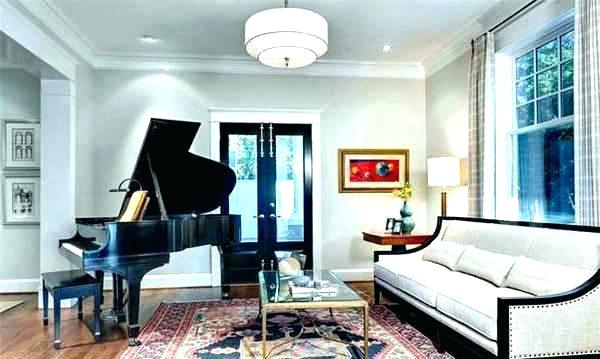
Recessed Ambient or General Lighting – You will use recessed ambient lighting when you are trying to provide general lighting in a room without accenting anything in particular or for a specific purpose. This is what most of the recessed lighting layout and designs will be used for. I am talking about providing a nice consistent light throughout the entire room.
Identify the Area That You Need to Light
When determining the area that you need to light with recessed lighting, it is not just the dimensions of the room. Yes, one of the first things that you do is measure. What I am referring to is whether you are using recessed lighting for task, accent or general lighting in the room first. Then, is there something about the room that needs to be considered?
Is your room used for more than one purpose and do you have areas of your room that may need to be lit differently? The perfect example of this is the kitchen. You may have the area where your sink, island, stove and refrigerator are and then also a different area where you have your table. You may need to place the lights strategically based upon those needs which is why you need to identify the area that you need to light before moving onto the next step.
In the image below, you can see examples of where you may strategically place the recessed lighting fixtures (yellow) based upon the flow of your kitchen. The red dots show where you may have additional task recessed lights that could even be a different size or these can also be pendants.
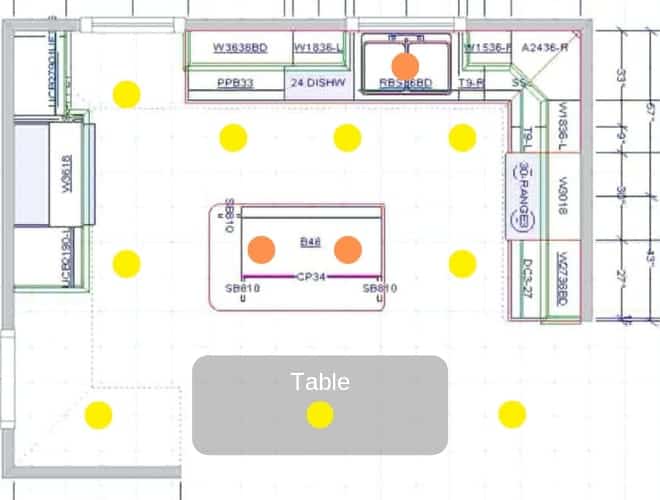
Decide on Which Recessed Lights You Will Use
The decision on which recessed lights you want to use will play a small part on how to layout recessed lighting in your room. If you plan to use smaller lights which may give off fewer lumens, then you may end up having to use more of them and space them closer together. If you are using larger 5-6 inch recessed lighting fixtures that are very bright, then you can space them farther apart and use fewer of them.
The other thing to consider is factoring in the size of your room, the total number of lights needed based upon your calculation below, and also the total watts you will need to manage through your switch or dimmer. I always recommend using an LED dimmer with all recessed lighting applications. Each dimmer will have a maximum watt capacity.
For smaller rooms, you should not have anything to be concerned about. However, if you plan to light an entire basement with many lights then the light decision will matter.
Click to see our recommended recessed lighting fixtures – There are always special deals being offered.
Calculate the Number of Recessed lights needed
Let’s assume that you are trying to layout recessed lighting for general or ambient lighting in a room with even light distribution. When determining how to layout recessed lighting for even light distribution, a good guideline is to average a minimum of one light for every 25 square feet of living space. For example, if your room is 12ft x 12ft (144 square feet), you will likely need a minimum of 6 recessed lights (144 ÷ 25 = 5.76). See picture below
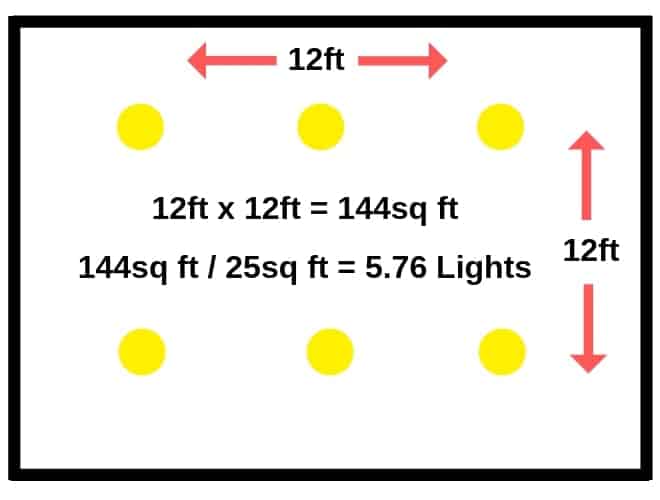
Keep in mind that this is a general guideline for ambient lighting. If you have a unique room layout or if it is a kitchen or a bathroom, you may need more or less lights. This is where the strategic layout of recessed lighting versus an even layout of recessed lighting is preferred.
You may need one over your cooktop area. One over your sink if you are not using a pendant. Lights over your island and kitchen table area and then the rest to fill in where needed. This is detailed in the photo above.
To repeat what I said a moment ago about the dimmer, make sure you figure out the total watts needed for your recessed lighting project and whether the dimmer can handle it.
Determine the layout of your Recessed lighting
Now that you have done all of the research above, you can work on how to layout recessed lighting in your room. This process will be for your general ambient lighting application although some of these components apply to all.
One last thing you need to do before determining the layout of your recessed lighting is to find the ceiling joists. This is an often overlooked step that can result in a minor home improvement disaster. You must first mark where your ceiling joists are and from there, you will have to adjust your layout to make sure the light fixtures can fit in between them. This will also help you to understand how and where to run the wiring during installation. This is critical.
A basic concept to follow is to keep the outer light fixtures at least 3 feet from the wall. This is a good distance to provide even light to the outer edges of the room without lighting up the wall so much that you can see every imperfection.
I like to start by marking the where the fixtures will go in each corner by placing a mark 3 feet from each wall as detailed in the diagram below. You may need to adjust slightly based upon where the ceiling joists are.
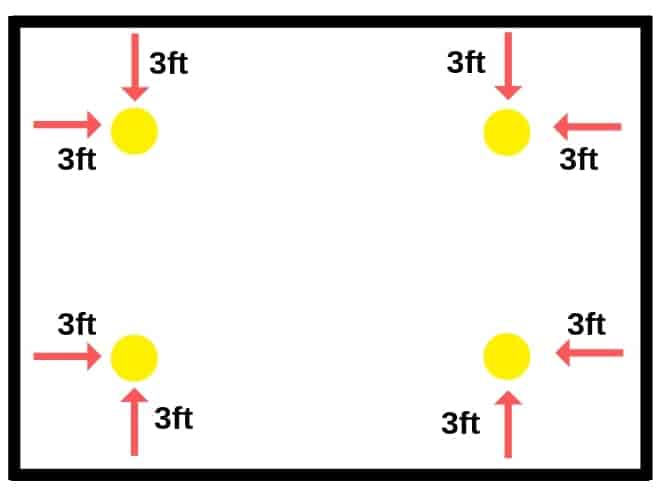
Now that you have the corners set, you need to fill by spacing out the recessed lighting fixtures. When it comes to spacing recessed lighting apart, industry standard is to divide the ceiling height in half and then use that number as your spacing guide. If you were to follow this, then lights for an 8 foot ceiling would be spaced 4 feet apart. Lights for a 10 foot ceiling would be spaced 5 feet apart, etc etc.
I am not fully on board with that method, but I am okay if you use it. There are other factors that would have an impact on this. I mentioned the size of recessed light fixtures and the number of lumens they put out. The other factor is whether the recessed lighting fixture is recessed up into the fixture or whether it is flush to the ceiling.
You can see the difference below in the side by side photo. The one that is recessed up into the fixture on the left will have limited ability to spread light across the room. The one on the light is more flush and will have a wider angle. This should be considered when spacing them.

In a recent recessed lighting project at home, I spaced some of the lights as far as 7 feet from each other. This means that each fixture would need to really just provide lighting 3 ½ feet meeting the other fixture half way. This is easily managed by any flush mount LED recessed lighting fixture. I can tell you that the room is lit perfectly with this spacing.
In a finished basement with a total of 230 square feet and 7 foot ceilings, there are 8 recessed lights covering an average of 28.75 square feet each. They are spaced anywhere from 4.5ft – 5.5ft from each other and also provide more than adequate light coverage. Especially when you consider that the ceiling is a foot lower than the standard 8 feet.
If you have not selected your recessed lighting yet and would like to potentially save money, then take a look at our recommended recessed lighting fixtures.
Summary
The most important part of any project is planning, and lighting projects are no different. When determining how to layout recessed lighting, just follow the steps above. Measure often, mark where the ceiling joists are and then use the guidance provide above plus some common sense based upon your unique situation.
If you have any questions about how to layout recessed lighting, leave a comment below and I will respond quickly.
Related Questions
How far should recessed lighting be from kitchen cabinets?
Recessed lighting should be roughly 2 feet from the cabinets. Recessed lighting in the kitchen serves multiple functions and providing light over your counters which are directly below the cabinets is important. This is why recessed lights are placed closer to your cabinets than they are to a wall.
How many recessed lights can you put on a 15 amp circuit?
Each 15 amp circuit can handle 1800 watts. Simply divide the number of watts your recessed lighting fixtures require into 1800 and that will tell you how many recessed lights can be put on a 15 amp circuit. If you are installing LED lights, then the circuit can handle more than you will need. What you should check into is what else may be on that circuit.
Can you put recessed lights between floors?
Recessed lights can be installed between floors but you will need shallow depth, air tight IC rated fixtures. The shallow recessed lighting fixtures will fit in the space between the floors and IC rated means they will not overheat if exposed to insulation.
Related Articles
How to Make Recessed Lighting Energy Efficient
Is Recessed Lighting Going Out of Style?
Why Do LED Lights Buzz When I Dim Them?

Regarding recessed lighting distance from kitchen cabinets, wouldn’t 2 ft from the cabinet mean that in many cases you would then have the light behind you thereby creating a body shadow falling over the task area on the counter top below that cabinet? Would you be better off placing the light on the ceiling in line with counter top edge?
The ceiling height helps to eliminate the possibility of a shadow. It also allows for some of that light to get beneath the cabinets just a bit. Remember, the counter top edge will be about 1 foot from the edge of the cabinet. So, you are really only talking about 1 foot back a few feet over your head.
That makes sense that you would want to have the lights closer to the cabinets so that you could see inside easier. My kitchen is kind of dark and I am thinking about getting someone to add some recessed lights. If I do I’ll have to make sure to calculate where I should put them all in the room to maximize their effectiveness.